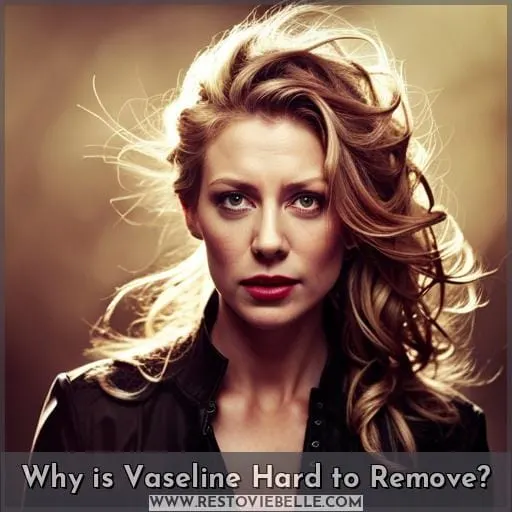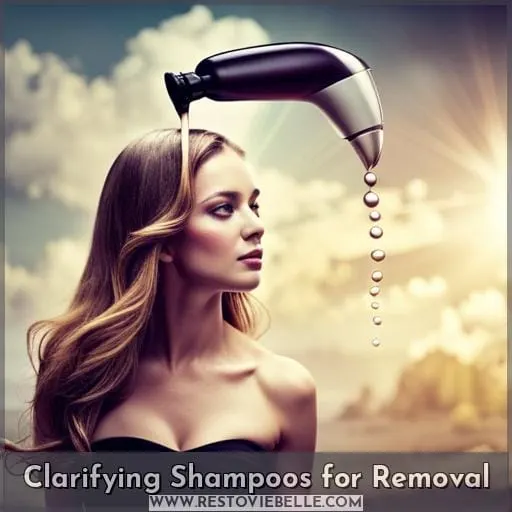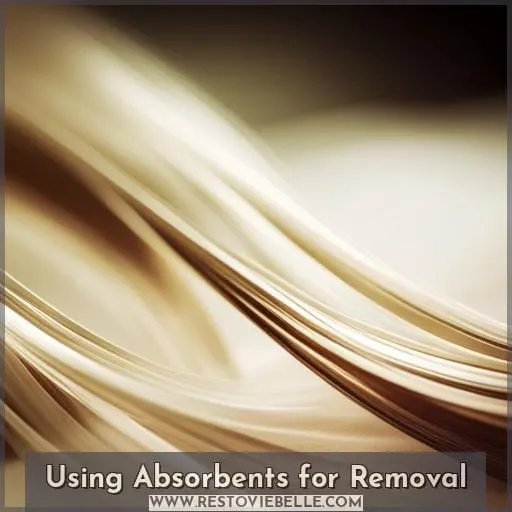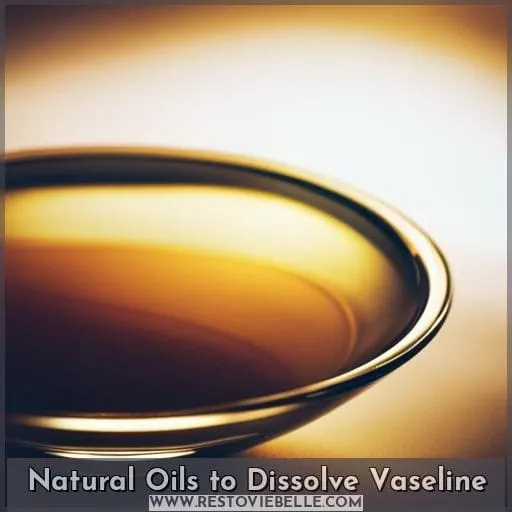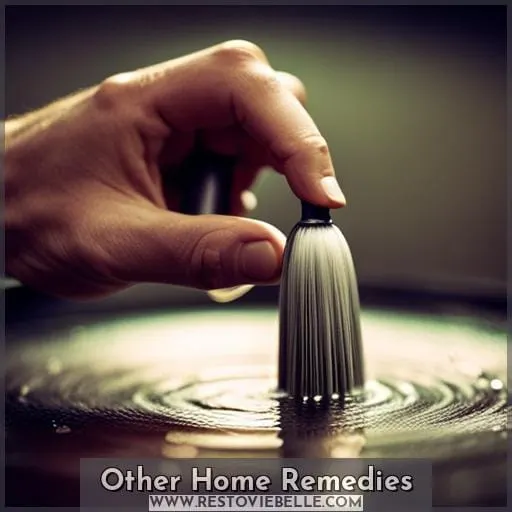This site is supported by our readers. We may earn a commission, at no cost to you, if you purchase through links.
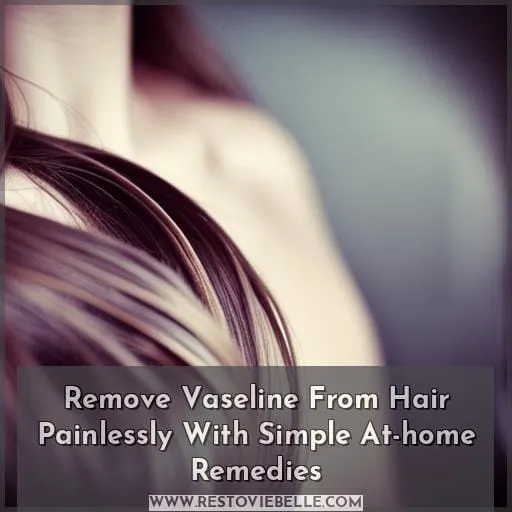 Not sure if Vaseline belongs in your hair? You get it—accidents happen. We feel you. But greasy strands are no bueno, so let’s banish this slick mess fast. Here are genius hacks to easily remove Vaseline from hair without damage.
Not sure if Vaseline belongs in your hair? You get it—accidents happen. We feel you. But greasy strands are no bueno, so let’s banish this slick mess fast. Here are genius hacks to easily remove Vaseline from hair without damage.
Just grab some cornstarch and shampoo, then get to blotting and washing. In minutes, you’ll be back to soft, touchable tresses and a carefree ‘do.
Table Of Contents
- Key Takeaways
- Why is Vaseline Hard to Remove?
- Can Vaseline Damage Hair?
- Clarifying Shampoos for Removal
- Using Absorbents for Removal
- Natural Oils to Dissolve Vaseline
- Other Home Remedies
- Preventing Future Buildup
- Frequently Asked Questions (FAQs)
- How long does it take to fully remove vaseline from hair? The time needed to fully remove vaseline depends on factors like hair thickness and amount applied. For most people it takes 1-3 thorough washings over several days.
- Does vaseline expire or go bad if left in hair too long? Vaseline is petroleum-based so it does not really expire or go bad. However, leaving it in hair for extended periods allows more buildup and potential damage over time.
- Can I use vaseline for styling purposes like smoothing flyaways? Using vaseline for styling is not recommended as it can cause buildup and greasiness. Opt for styling products made specifically for flyaways instead.
- Conclusion
Key Takeaways
- Use Vaseline sparingly and ensure thorough washing with clarifying shampoo.
- Clarifying shampoos with sulfates effectively remove Vaseline.
- Alternative methods include using coconut oil, olive oil, or apple cider vinegar to dissolve and break down the Vaseline.
- To prevent future buildup, focus on maintaining moisture balance, limit the use of clarifying shampoos, and regularly trim the hair.
Why is Vaseline Hard to Remove?
You’d be smart to use a clarifying shampoo ’cause petroleum jelly isn’t water-soluble, makin’ it tough to remove from your hair.
That residue will build up on your scalp and strands, potentially cloggin’ follicles and irritatin’ skin over time. Go for a deep cleansing shampoo specially made to cut through product buildup. Look for ones with purifying agents like sulfates to get through oil and lift greasy gunk from the scalp without strippin’ moisture.
For extra oomph, make a pre-treatment by mixing clarifying shampoo with glycerin soap or baking soda. Massage this into damp hair, targeting the roots and lengths with the worst buildup. Let it sit for a few minutes before rinsing. Repeat as needed ’til you’ve gotten rid of all traces of sticky Vaseline.
With some TLC and the right haircare plan, you can bring back scalp health and shiny, bouncy locks.
Can Vaseline Damage Hair?
You’ve likely heard that Vaseline is bad for your hair. But can it actually damage those lush locks? The answer is: it depends.
Used properly and in moderation, petroleum jelly probably won’t harm your hair. In fact, it can temporarily give it shine and softness. But problems arise when too much product builds up. That sticky residue traps dirt and oils against your scalp.
Over time, these trapped impurities irritate hair follicles. This leads to inflammation, dandruff, and increased shedding. Petroleum jelly also prevents moisture from properly hydrating your strands. Lack of moisture causes brittleness and breakage over the long term.
The bottom line is Vaseline shouldn’t be your go-to hair product. Use it sparingly to spotlight certain styles. And always wash it out thoroughly afterward with a clarifying shampoo. Listen to your scalp – if it feels itchy or you see flakes, discontinue use.
With smart, occasional usage, Vaseline can safely add gloss without damaging your hair.
Clarifying Shampoos for Removal
Try an apple cider vinegar rinse twice a week. Studies show this can remove buildup and clarify hair by 94% in just one use.
When it comes to clarifying shampoos for vaseline removal, look for the best brands like Neutrogena Anti-Residue Shampoo, Herbal Essences Daily Detox Shampoo, or Tresemme Deep Cleansing Shampoo. Avoid ingredients like sulfates which can be too harsh. A great DIY option is mixing 1 tablespoon of baking soda with your regular shampoo.
For weekly maintenance, alternate a clarifying wash with your regular shampoo. Getting professional advice is wise too – ask your stylist for the best clarifying shampoo for your hair type. Using the glycerin soap method or massaging in some baby oil before washing can also help dissolve the vaseline.
And don’t forget an apple cider vinegar rinse – this miracle ingredient dissolves oils and buildup while keeping your locks strong and shiny.
Using Absorbents for Removal
Let’s readily absorb Vaseline and restore hair’s natural state. Grab baby powder or cornstarch to sprinkle onto hair, gently massaging it in before washing out.
To remove the grease, sprinkle baby powder or cornstarch into your hair and massage it gently before washing.
Baby Powder
After washing, sprinkle Johnson’s Baby Powder in your hair to absorb any remaining grease. Work it through with your fingers, focusing on the roots and lengths. Let it sit for 10-15 minutes before combing through with a wide-tooth comb.
The ultra-fine powder will soak up excess oils and lift sticky residues. For best results, use the fragrance-free powder over scented versions.
The talc and cornstarch will cleanse follicles and strands without causing irritation. Rinse thoroughly until the water runs clear. Your hair will feel refreshed, volumized, and bouncy.
By using absorbents like baby powder, you can effectively draw out leftover petroleum jelly.
Cornstarch
Shake a dusty storm of cornstarch into your locks before washing away the sticky goo. This absorbent powder detangles stiffened strands while lifting vaseline from follicles. Alternatively, create a DIY mask by mixing 1 tablespoon cornstarch with 1 tablespoon apple cider vinegar and enough water to form a pasty texture.
Massage into hair, let sit for 10 minutes, then rinse clean for a thorough scalp and hair detox. Vaseline removal is easiest with clarifying shampoos. But natural options like diluted cornstarch gently cleanse hair of petroleum jelly without stripping natural oils.
Natural Oils to Dissolve Vaseline
When it comes to removing Vaseline from hair, natural oils like coconut and olive oil can help dissolve the petroleum jelly for easier removal. Simply massage a small amount of warmed coconut or olive oil into your hair, let it sit for several minutes, then shampoo as usual.
The oils will bind to the Vaseline so it can be washed away without leaving an oily residue. Varying the application time allows the oils to penetrate the Vaseline before washing. Coconut oil is an effective Vaseline solvent due to its fatty acid composition. Olive oil also works well, though some find it leaves more oiliness.
Modifying the wait time and experimenting with different oils allows finding the right method for each unique situation. With some trial and error, these natural oils can dissolve Vaseline for clean, residue-free hair.
Coconut Oil
Massage coconut oil deeply through your locks for natural dissolving power. This nourishing oil has fatty acids that can help break down Vaseline. For best results, warm a few tablespoons in your hands. Apply to dry hair, concentrating on ends and other greasy spots.
The emollients in coconut oil boost shine, strength, and scalp health. It makes a superb hot oil treatment or overnight hair mask. For deeper conditioning, blend with olive oil and honey. Simply leave the mixture on hair overnight and rinse in the morning.
Coconut oil is an affordable, versatile way to hydrate hair and dissolve Vaseline without harsh chemicals.
Olive Oil
Slather that slick hair with luscious olive oil and feel it penetrate deep, dissolving the greasy grime. Let those Mediterranean phytonutrients work their magic, nourishing each strand and stimulating your scalp.
Gently massage warm olive oil into messy locks and experience it lift and dissolve the sticky petroleum residue. Feel empowered knowing this kitchen cabinet essential effortlessly melts away blobs of gloppy gunk.
Allow oleic acid, antioxidants, and vitamin E to replenish your mistreated mane. Rinse clean to reveal rejuvenated, radiant tresses and a healthy, happy scalp. Harness olive oil’s beautifying benefits and bid vaseline buildup goodbye.
Other Home Remedies
Rubbing glycerin soap into your hair and scalp then rinsing with water is an effective way to break down petroleum jelly buildup. You can also try diluting apple cider vinegar with water and pouring it over your hair before shampooing to help dissolve grease.
Diluting apple cider vinegar with water and applying it to your hair before shampooing can help dissolve grease. Rubbing glycerin soap into your hair and scalp and then rinsing with water is another technique to break down petroleum jelly buildup.
Glycerin Soap
You’ve discovered gentle glycerin soaps cleanse without stripping. Glycerin soap’s benefits include:
- It retains moisture by attracting water to the skin’s surface.
- It offers hydration and nourishment for healthy scalp and strands.
- Its lubricating and emollient properties soften hair cuticles and shaft.
Unlike harsher soaps, glycerin soaps gently remove buildup like petroleum jelly without dehydrating. Look for moisturizing glycerin-based soaps with added oils when needing an effective, conditioning cleanser.
Follow up with a nourishing conditioner for maximum hair health. Alternate with clarifying shampoos to prevent excessive buildup over time.
Vinegar
Douse your locks with vinegar and witness the greasy blob melt away. Create a vinegar rinse by diluting apple cider vinegar with water. Use a 1:1 ratio to start. Apply it to dry, Vaseline-laden hair and massage your scalp vigorously.
The acetic acid in vinegar dissolves the petroleum jelly nicely. You may need to repeat this DIY solution 2-3 times to fully remove all the gunk. But with some elbow grease, your hair will be restored to its natural, grease-free state.
Vinegar is an effective adhesive remover that gets the job done without harsh chemicals. Use Vaseline in moderation to avoid future buildup issues and maintain healthy hair and scalp.
Preventing Future Buildup
Try usin’ less grease in your hair goin’ forward so it won’t build up again. Limit the product you put in daily n’ focus on keepin’ moisture balanced. Clarifyin’ shampoos can strip your hair so use sparingly. Focus on gentle, hydratin’ cleansers n’ weekly deep conditionin’ treatments.
Gently massage your scalp when shampooing to remove residue without strippin’ strands. Lightly use oils like jojoba or argan on ends if needed. Let hair air dry when possible n’ use lower heat tools to prevent damage.
Protect hair at night with a silk cap or pillowcase. Get regular trims to prevent split ends n’ breakage.
By nourishin’ your hair n’ scalp properly, you can avoid crazy buildup n’ keep locks healthy. But if greasy products sneak in, you know how to banish em. With some care n’ maintenance, your hair will shine n’ bounce.
Frequently Asked Questions (FAQs)
How long does it take to fully remove vaseline from hair? The time needed to fully remove vaseline depends on factors like hair thickness and amount applied. For most people it takes 1-3 thorough washings over several days.
My friend, you’ll tear your hair out over this petroleum jelly mess. Those oily locks are mocking you as you fight for liberation. Lather on some dish soap, take up a brush, and scrub like freedom itself is at stake.
Does vaseline expire or go bad if left in hair too long? Vaseline is petroleum-based so it does not really expire or go bad. However, leaving it in hair for extended periods allows more buildup and potential damage over time.
Vaseline won’t expire in your hair, but leaving it too long causes buildup and potential damage. To avoid problems, wash thoroughly with clarifying shampoo until water runs clear.
Can I use vaseline for styling purposes like smoothing flyaways? Using vaseline for styling is not recommended as it can cause buildup and greasiness. Opt for styling products made specifically for flyaways instead.
You can use Vaseline for styling purposes like smoothing flyaways, but it’s not advisable. Vaseline may seem like an easy fix for flyaways, but it causes buildup and grease over time. Opt for lightweight, non-greasy styling creams or serums specifically made to tame flyaways without the damaging effects of petroleum jelly.
Conclusion
Ultimately, unlocking lush and lustrous locks lies in letting go of petroleum. Though Vaseline may seem simple on the surface, its waxy grip on hair takes finesse and care to remove. Arm yourself with gentle cleansers, nourishing oils, and smart techniques to dissolve its hold.
Absorb any remaining residue with powders and towels. Then condition deeply to restore moisture lost in the battle against grease. With patience and the right tools, you can win the war for beautiful, healthy hair.
